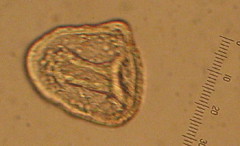![]()
![]()
![]()
Use LEFT and RIGHT arrow keys to navigate between flashcards;
Use UP and DOWN arrow keys to flip the card;
H to show hint;
A reads text to speech;
18 Cards in this Set
- Front
- Back
|
Seminiferous Tubules
|
where sperm is formed
|
|
|
Sertoli Cells
|
Nourish and protect developing sperm
|
|
|
Leydig Cells
|
Surround seminiferous tubules and produce testosterone and other androgens
|
|
|
Prostate Gland
|
Contributes anticoagulant and citrate, a nutrient for sperm
|
|
|
Bulborethral Gland
|
Secretions from here neutralize the pH in urethra
|
|
|
Polar Body
|
Due to unequal cytokinesis, this nucleus does not receive any cytoplasm after meitotic division occurs
|
|
|
LH
|
Spikes in this trigger ovulation in response to estrogen feeding back on the hypothalamus
|
|
|
Progesterone
|
Maintains endometrium
|
|
|
Corpus Luteum
|
Secretes progesterone and estradiol
|
|
|
FSH
|
stimulates follicles to grow
|
|
|
Human Chorionic Gonadotropin (hCG)
|
maintains the corpus luteum and endometrium
|
|
|
Cell Division
|
Produce more cells by mitosis
|
|
|
Morphogenesis
|
cells rearrange in the developing embryo
|
|
|
Differentiation
|
The cells specialize into different tissues
|
|
|
Blastula
|
a hollow ball of cells
|
|
|
Gastrulation
|
Cells on one end of the blastula migrate into the center to begin forming the digestive system
|
|
|
Gastrula
|

|
|
|
Organogenesis
|
Organ formation in which cells within the 3 embryonic layers differentiate to form the tissues and migrate to take up their positions in the newly forming organs
|

